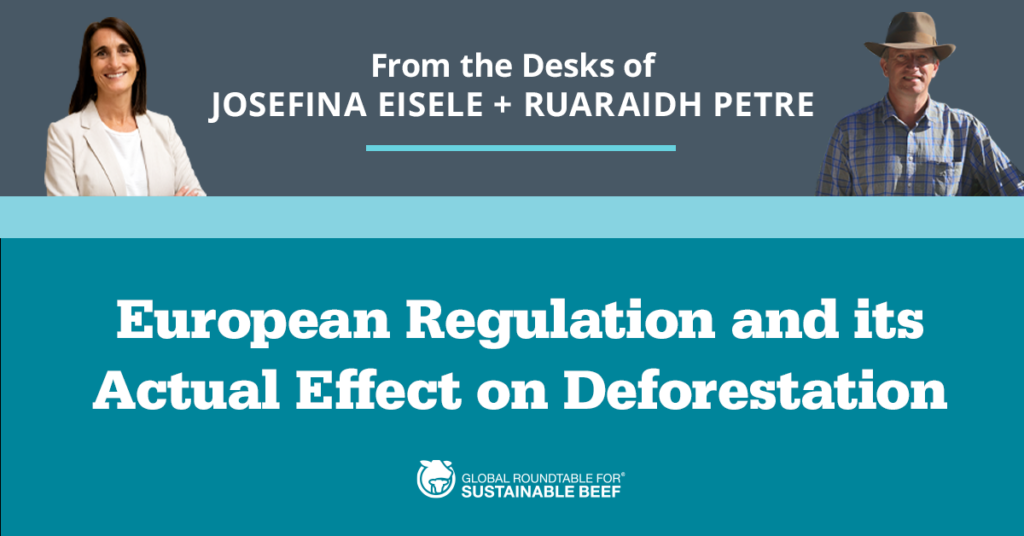European Regulation and its Actual Effect on Deforestation
From the desks of Josefina Eisele and Ruaraidh Petre
For Brazil, Europe currently represents only 1% of its exports; for Argentina, it is 13% (2020). Beyond the percentages, the prices that Europe pays for the types of cuts that they buy are attractive to most exporters and it is a market that they want to preserve and grow.
Personally, I do not think that the EUDR alone is going to solve the problem of deforestation. It has definitely created awareness and has led to discussions with an increasingly high level of knowledge about Deforestation, Degradation, and Conversion as well as definitions as to what are considered Forests and what are not, and this in itself is positive.
The EUDR has generated discussions on “environmental” traceability, beyond the already existing sanitary traceability for Europe. It has also started exchanges with local governments on access to data, information of origin, georeferencing, and the importance of public-private collaboration which has become evident since the Regulation falls on the private sector (exporters) but the origin (farm/production unit) and transportation data for the products generally come from public sources.
Technology has advanced a lot in recent times through BlockChain, satellites, and multiple applications and programs that allow faster access to information. I believe that this is the beginning of new directions for international and local trade to take. The need to provide information in a transparent and rapid manner is vital, not only in terms of deforestation or conversion, but also on emissions, human rights, health, and animal welfare, and type of production system such as grass-fed or feedlot beef. Consumers are increasingly aware of the issues and want to be informed on the origin of what they consume.
We already know that the EU regulations on deforestation will be followed with somewhat different requirements by the United Kingdom and the United States. Possibly, China will also have environmental requirements at some point, which is why it is important that we all prepare and collaborate between different institutions.
On the other hand, I believe it is essential that there be more discussion forums, where regions such as Latin America can bring their perspectives regarding the social and economic importance of livestock, and the impact that this region has on Climate Change and the problems that face the world today.
Happily, I see that there are multiple organizations that are working on sustainable livestock, the challenge is to collaborate among all and join efforts. With IICA we are achieving it, and that is a great step.
The COPs also represent a great opportunity, where we can all come together and carry a consensual message with data based on science.
I think there is still a lot to do, but I feel that we are on the right track. The challenge is not to slow down, but quite the opposite, to be more efficient and open to working together towards the same goal, improving the sustainability of livestock.
____
This month we hosted a webinar on the EU deforestation regulation and the ways to comply for the cattle industry. We were joined by Gert van der Bijl, Sr. EU Policy Advisor, Solidaridad; Charlotte Zandbergen, Chief Marketing Officer, Zandbergen World’s Finest Meat; Maria Eugenia Periago, Sustainable Management and Production Program Coordinator, Fundacion Vida Silvestre; and Fernando Sampaio, Sustainability Director, Brazilian Beef Exporters Association (ABIEC).
From Gert van de Bijl of Solidaridad’s presentation, I understood that in terms of Europe’s deforestation ‘footprint’ beef is actually a small contributor, due in large part to existing controls on beef imports. So at the moment, the estimate is that beef imports represent around 3% of the deforestation that Europe is associated with through imports.
Other commodities are more significant, and some of them may not be on everyone’s radar. Rubber, for example, is actually one of the largest contributors to EU’s deforestation footprint. Others are likely much more familiar, including palm oil, soy and other crop commodities, and those can and are also involved in feed supply chains and therefore can also be implicated in livestock production.
From further conversations, it seems that as Europe has a deficit in beef production, and as Brazil is exporting a growing proportion of their beef (from a low of 20% to about 30% now) we would expect to see the 1% that they are currently sending to the EU grow in the future.
What EUDR will do is create a filter on that growth to make sure that it is deforestation-free. The assumption in Europe must be that this will lead to a decrease in deforestation, though I think that is less certain, unless others start using the same framework. Those others could include other importing regions such as the US.
China is the largest importer of Brazilian Beef, with the Middle East and Egypt below them. Rather than expecting those markets to impose deforestation conditions on imports, it is more likely that the finance sector could do so, which could end up having broader implications. If the finance sector adopts EUDR as a general requirement for investments covering commitments from countries with a perceived deforestation risk it could become very influential, in the way, for example, that SBTi is influential in climate impact.
